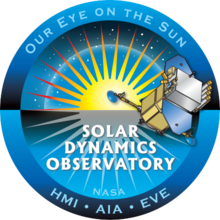 Solar Dynamics Observatory satellite | |
| Names | SDO |
|---|---|
| Mission type | Solar research[1] |
| Operator | NASA GSFC[2] |
| COSPAR ID | 2010-005A |
| SATCAT no. | 36395 |
| Website | http://sdo.gsfc.nasa.gov |
| Mission duration | 5 years (planned) 14 years, 9 months, 11 days (elapsed) |
| Spacecraft properties | |
| Spacecraft type | Solar Dynamics Observatory |
| Manufacturer | Goddard Space Flight Center |
| Launch mass | 3,100 kg (6,800 lb) |
| Dry mass | 1,700 kg (3,700 lb) |
| Payload mass | 290 kg (640 lb) |
| Start of mission | |
| Launch date | 11 February 2010, 15:23:00 UTC |
| Rocket | Atlas V 401 |
| Launch site | Cape Canaveral, SLC-41 |
| Contractor | United Launch Alliance |
| Orbital parameters | |
| Reference system | Geocentric orbit[3] |
| Regime | Geosynchronous orbit |
| Longitude | 102° West |
 Solar Dynamics Observatory patch Large Strategic Science Missions Heliophysics Division Living With a Star program | |
The Solar Dynamics Observatory (SDO) is a NASA mission which has been observing the Sun since 2010.[4] Launched on 11 February 2010, the observatory is part of the Living With a Star (LWS) program.[5]
The goal of the LWS program is to develop the scientific understanding necessary to effectively address those aspects of the connected Sun–Earth system directly affecting life on Earth and its society. The goal of the SDO is to understand the influence of the Sun on the Earth and near-Earth space by studying the solar atmosphere on small scales of space and time and in many wavelengths simultaneously. SDO has been investigating how the Sun's magnetic field is generated and structured, how this stored magnetic energy is converted and released into the heliosphere and geospace in the form of solar wind, energetic particles, and variations in the solar irradiance.[6]
- ^ "SDO Our Eye on the Sun" (PDF). NASA. Retrieved 13 February 2010.
 This article incorporates text from this source, which is in the public domain.
This article incorporates text from this source, which is in the public domain.
- ^ Dean Pesnell; Kevin Addison (5 February 2010). "Solar Dynamics Observatory: SDO Specifications". NASA. Archived from the original on 30 January 2010. Retrieved 13 February 2010.
 This article incorporates text from this source, which is in the public domain.
This article incorporates text from this source, which is in the public domain.
- ^ "SDO 2010-005A". N2YO. 24 January 2015. Retrieved 25 January 2015.
- ^ Bourkland, Kristin L.; Liu, Kuo-Chia (25 July 2011). Verification of the Solar Dynamics Observatory High Gain Antenna Pointing Algorithm Using Flight Data (Report). American Institute of Aeronautics and Astronautics. hdl:2060/20110015278.
- ^ Justin Ray. "Mission Status Center: Atlas V SDO". Spaceflight Now. Retrieved 13 February 2010.
- ^ Dean Pesnell; Kevin Addison (5 February 2010). "Solar Dynamics Observatory: About The SDO Mission". NASA. Archived from the original on 30 June 2007. Retrieved 13 February 2010.
 This article incorporates text from this source, which is in the public domain.
This article incorporates text from this source, which is in the public domain.